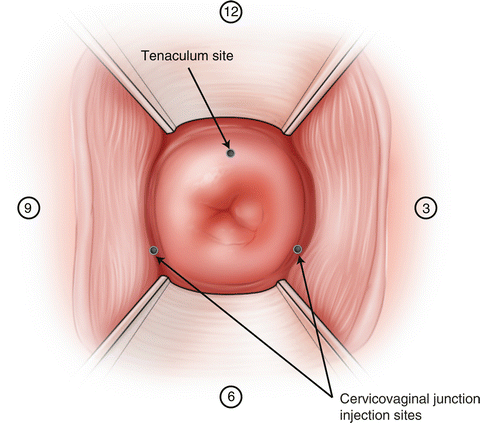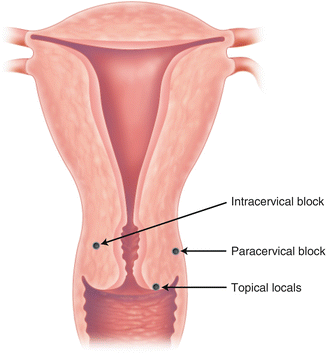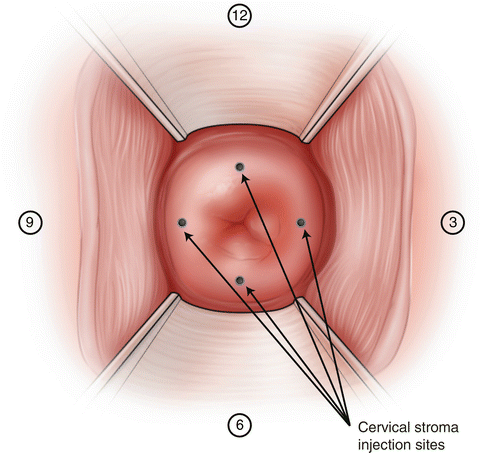Fig. 4.1
Receptors for local anesthetics: only the nonionized form of the local can cross the cell membrane, but it is the ionized form that binds to the intracellular receptor
Duration of action is more multifactorial. The degree of protein binding of the local anesthetic involved is a main component. Lipid solubility and blood flow also play important roles (Table 4.1).
Table 4.1
Basic clinical properties of common local anesthetics
Generic (trade) | Potency/lipid solubility [2] | ||
|---|---|---|---|
Amides | |||
Bupivicaine (Marcaine) | High | 8.1 (5 min) | High (~2–4 h) |
Lidocaine (Xylocaine) | Moderate | 7.8 (<2 min) | Moderate (0.5–1 h, 1.5–2 h with 1:200,000 epi) |
Mepivacaine (Carbocaine) | Moderate | 7.6 (3–5 min) | Moderate (0.5–1.5 h) |
Ropivacaine | High | 8.1 (5 min) | High (~2–4 h) |
Esters | |||
Chloroprocaine (Nesacaine) | Low | 9.0 (<2 min) | Low (0.5–0.75 h) |
Tetracaine (Pontocaine) | High | 8.2 (3–10 min) | Mod-high (2–3 h) |
It is also important to understand that not all nerves are equally affected by local anesthetics. Several factors come into play when determining a nerve’s sensitivity to locals. These include axonal diameter, degree of myelination, and classification of nerve (i.e., Aα, Aβ, C, etc.). Clinically, this is manifested by a patient’s loss of temperature and pain sensorium, while still maintaining proprioception, pressure awareness, and motor function [1].
The properties of local anesthetics can also be improved on and augmented. Vasoconstrictors, most commonly epinephrine, vasopressin, and phenylephrine, have been used in conjunction with locals to decrease vascular absorption and thereby increase the duration, improve overall quality, and decrease toxicity [1, 2]. Multiple other medications have been added as well, including clonidine, dexamethasone, and dexmedetomidine [2]. Specific adjunct will be discussed later with each particular regional block.
Use of local anesthetics necessitates that a provider be familiar with the complications that can arise with their use. These would include vasovagal response, toxicity, anaphylaxis, accidental intravascular injection, methemoglobinemia, and drug interactions.
Local anesthetic toxicity is a rare but serious complication of regional anesthesia. It is most often related to the local agents potency: the more potent the anesthetic, the greater the risk of toxicity [2]. There is a wide degree of toxicity from mild to severe to life threatening. Causes can include incorrect dosage (see Table 4.2), poor hepatic clearance, accidental intravenous injection, or worse, accidental intra-arterial injection. As with most procedural complications, early recognition of symptoms and rapid intervention are paramount (Table 4.2).
Table 4.2
Maximum safe dosage of local anesthetics by weight
Local anesthetic | Maximum dose (mg/kg) [2] |
|---|---|
Esters | |
Chloroprocaine | 12 |
Cocaine | 3 |
Procaine | 12 |
Tetracaine | 3 |
Amides | |
Lidocaine | 4.5 (w/o epinephrine), 7 (w/ epinephrine) |
Bupivacaine | 3 |
Ropivacaine | 3 |
Mepivacaine | 4.5 (w/o epinephrine), 7 (w/ epinephrine) |
Prilocaine | 8 |
The central nervous and cardiovascular systems are particularly susceptible to the effects of local anesthetic toxicity [2]. The nervous system is usually the first to be affected. Classic symptoms include circumoral numbness, dizziness, and tinnitus. This is followed by an excitatory phase where the patient demonstrates restlessness, agitation, or a sense of impending doom. Finally, if the case is severe enough, an inhibitory phase can be seen where the patient becomes drowsy, unconscious, and may eventually produce tonic-clonic seizures.
As a rule, due to local anesthetics’ nature as a sodium channel blocker, they all can have a profound effect on the cardiac muscle. In general, the more lipophilic a local is the greater the risk for cardiotoxicity [2]. Alterations in intrinsic cardiac electrical physiology can produce bradycardia. Increased dosages can lead to heart block and hypotension. Cardiovascular collapse can occur. However, it should be noted that the level of local anesthetic needed to produce a cardiovascular arrest is approximately three times the level needed to produce a seizure.
One additional benefit to regional anesthesia is that local anesthetics have relatively few drug interactions with other medications. However, it is important to note that local anesthetics do interact with each other, especially in terms of their toxicity. Local anesthetic toxicities are additive. For example, if a 50 % maximum dose of bupivicaine is used with a 50 % maximum dose of lidocaine, then the patient would be at 100 % the maximum allowed dose. Also, it is important to remember that amide locals are metabolized by the liver. Patients taking medications that alter the P450 system or with liver disease are at increased risk for toxicity and side effects [2]. The American Society of Regional Anesthesia and Pain Medicine (ASRA) has summarized all current literature in local anesthetic toxicity and produced guidelines for its treatment [3]. Some key points of the guidelines include:
Call for help early
Early airway management
Seizure suppression with benzodiazepines if necessary
Avoid vasopressin, calcium channel blockers, and beta blockers
Reduce initial epinephrine doses to <1 μg/kg
Treat with 20 % Lipid Emulsion Therapy (1.5 mL/kg bolus followed by 0.25 mL/kg/min infusion)
Drug allergies and anaphylactic reactions to local anesthetics are rare. They are more common with the ester locals. The esters are broken down in the blood by pseudocholinesterase. Para-aminobenzoic acid is a metabolite of this process and has been determined to be the true source of allergic reactions in most patients diagnosed with a local anesthetic allergy [1]. Because of this there is no cross-reactivity to amide in terms of anaphylaxis. True allergies to amide locals are exceedingly rare and have been associated with the preservative paraben, not the local itself.
Methemoglobinemia is a known possible effect of the use of prilocaine or benzocaine (common in anesthetic sprays). Symptoms include dyspnea, cyanosis, and altered mental status. Treatment of severe cases includes methylene blue 1–2 mg/kg [2].
Because of the possible complications, it is important that all necessary equipment be made available prior to any regional nerve block. In addition to the materials needed for the block itself, these items should always be present [4]:
A thoroughly evaluated and consented patient
A practitioner experienced with the technique to be used
Appropriate monitoring of the patient, i.e., cardiac monitoring, blood pressure, pulse oximetry, and temperature
Airway supplies including nasal cannulas, self-inflating bag-mask devices, and emergency airway equipment
Suction equipment
Intravenous cannulation equipment
Resuscitation cart with appropriate medications and cardiac defibrillator
Paracervical Block
Anatomy
Cervical innervation is derived from T11 to T12. Pain from cervical dilation is carried through parasympathetic fibers running with the cardinal ligament and uterine vessels. Pain associated with uterine contractions is transmitted via sympathetic nerve fibers in the hypogastric nerve and superior hypogastric plexus into the posterior roots of the spinal cord at their respective levels [5].
A paracervical block is aimed at interrupting these pathways by blocking nerve transmission at the level of the inferior hypogastric plexus [5]. It is located in the uterosacral ligament on either side of the cervix in the lateral vaginal fornices. Because of this, paracervical blocks may be utilized in any procedure in which cervical manipulation, dilatation, biopsy, or ablation is planned.
Solution
As with any nerve block, choosing the correct local anesthetic is an important decision. For the purpose of office gynecological procedures, many combinations are possible. Lidocaine 1 % is a standard for most blocks that require anesthesia for less than 1 h. However, any of the longer acting locals previously discussed can be used for procedures that are expected to last longer or requiring continued post-procedural pain relief. A good office solution typical includes a local, a vasopressor, and a buffer (typically sodium bicarbonate). The following mixture can be used for paracervical blocks in office:
50 mL of lidocaine 1 % (mepivacaine 1 % is also a good choice if anesthesia is needed for long procedures)
0.25 mL of epinephrine 1:1,000 (final concentration of 1:200,000)
5 mL of 8.4 % sodium bicarbonate
Equipment
1.
One 22 or 25 gauge Quincke spinal needle
2.
One 20 mL syringe for injection (larger syringes are not recommended as more force is exerted during the block)
3.
Sterile towels and sponges
4.
Sterile prep of choice (Note: Items 2–4 usually will be found in a standard block tray)
Procedure [5, 6]
1.
Internally and externally prep and drape your patient in your standard sterile fashion.
2.
If a tenaculum will be used for cervical manipulation, the needle is inserted into the cervical stroma at the 12 o’clock position and a small amount (<2 mL) is superficially injected, prior to the tenaculum being applied to the cervix (Fig. 4.2).


Fig. 4.2
Correct needle insertion sites for a paracervical block
3.
Next the needle is inserted about 1 cm into the cervical stroma at the 4 o’clock position at the cervicovaginal junction.
4.
Careful aspiration for blood on the syringe must be done prior to injection. If blood is obtained the needle should be withdrawn or advanced 1–2 mm until blood is no longer noted.
5.
Inject 10–15 mL of local solution.
6.
The needle should be removed and steps 3–6 should be repeated for an injection at the 8 o’clock position.
7.
Wait an appropriate amount of time prior to beginning your procedure. Lidocaine with epinephrine will have an onset of action of less than 2 min (for other locals, refer to Table 4.1).
Tips
1.
Depending on the amount of uterine descensus, a shorter needle rather than a spinal needle may be easier to administer the anesthetic.
2.
Aspirate your syringe several times throughout the course of your injection, particularly at the onset, halfway, and conclusion of injection. This will confirm that your needle has not moved during the block.
3.
Do not aspirate back on your plunger more than a couple mL’s. Over-aggressive aspiration can produce negative pressure and collapse blood vessels to produce a false negative. This would lead to inadvertent intravascular injection.
4.
Some physicians believe in divided doses on each side. This would lead to a total of four injections. Five milliliters each at 3, 5, 7, and 9 o’clock, or alternatively at 5 mL each 2, 4, 8, and 10 o’clock. Regardless of which approach is taken, the inferior hypogastric plexus and ganglia are blocked [5]. Technically, the 2, 4, 8, and 10 o’clock approach should be termed a uterosacral block. This, however, is purely semantics.
Several studies have tried to address these differences between techniques, depths, local anesthetic agent choice, and its concentration. Results have varied widely from no difference [7, 8] to significant difference [9–11]. Most of the studies that have shown no difference allowed relatively little to no time between injection and the beginning of the procedure. This fact reiterates the importance of understanding the local anesthetics and their pharmacological properties.
Complications
The most common complaint for paracervical blocks is pain upon initial insertion of the needle. This is simply a fact of doing regional anesthesia. For all but the simplest of in-office procedures, the benefits of the “pinch” far exceed the risks. However, complications can occur. Following a paracervical block, prolonged blockage or neuritis may occur. Prolonged blockage is usually a result of either too great a volume being injected or patient-specific pharmacokinetics. Neuritis is more often related to trauma to the nerves. Neuritis usually resolves in 1–2 weeks but has been known to linger for as long as 6 months [5].
Parametrial hematoma is another possible complication of a paracervical block. Usually, it requires no treatment. However, if neurological or vascular impairment is noted, incision and drainage may be needed [5].
Also, paracervical blocks done on the parturient have known associations with fetal bradycardia, fetal distress related uteroplacental insufficiency, inadvertent fetal injection, and death. For these reasons, paracervical blocks are not commonly used on pregnant patients anymore [2].
Intracervical Block
Anatomy
Intracervical blocks will block the same pain pathway as was described for the paracervical block. For this reason, intracervical blocks can be used for any procedure for which a paracervical block is indicated. Several studies have attempted to determine which block is superior for analgesia. While paracervical has been shown to provide good analgesic coverage [12], other blocks, such as the intracervical block, have been difficult for researchers to evaluate due to wide variations in techniques [13]. The anatomical differences in position for the block are noted in Fig. 4.3.


Fig. 4.3
Site comparison for paracervical, intracervical, and topical placement
Solution
The same solutions used for paracervical blocks can be used with intracervical. Again, a good mixture for office procedures planned for less than 1 h is:
50 mL of lidocaine 1 %
0.25 mL of epinephrine 1:1,000 (final concentration of 1:200,000)
5 mL of 8.4 % sodium bicarbonate
Equipment
1.
One 20-gauge needle (larger bore needle needled to compensate for the increased resistance of the cervical stroma)
2.
One 20 mL syringe for injection (larger syringes are not recommended as more force is exerted during the block)
3.
Sterile towels and sponges
4.
Sterile prep of choice (Note: Items 2–4 usually will be found in a standard block tray)
Procedure [5, 6]
1.
Internally and externally prep and drape your patient in your standard sterile fashion.
2.
The needle is inserted about 1 cm into the cervical stroma at the 12 o’clock position (Fig. 4.4).




